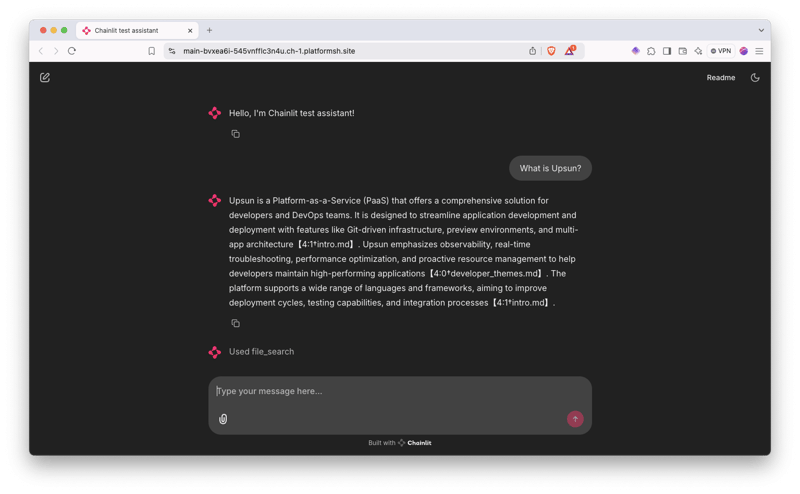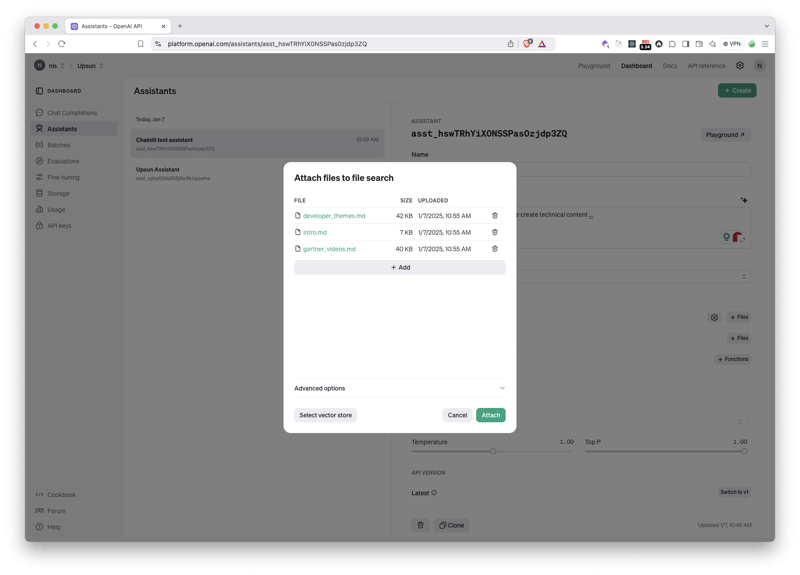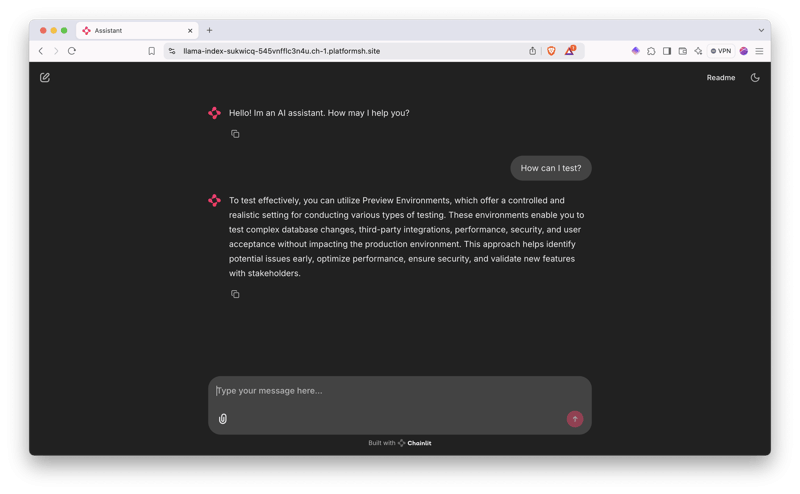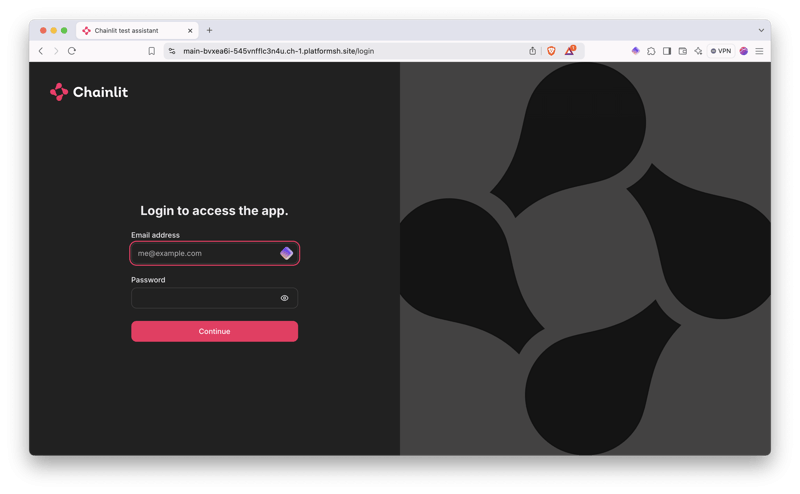Experiment with Chainlit AI interface with RAG on Upsun
Chainlit: A Scalable Conversational AI Framework
Chainlit is an open-source, asynchronous Python framework designed for building robust and scalable conversational AI applications. It offers a flexible foundation, allowing developers to integrate external APIs, custom logic, and local models seamlessly.

This tutorial demonstrates two Retrieval Augmented Generation (RAG) implementations within Chainlit:
- Leveraging OpenAI Assistants with uploaded documents.
- Utilizing llama_index with a local document folder.
Local Chainlit Setup
Virtual Environment
Create a virtual environment:
mkdir chainlit && cd chainlit python3 -m venv venv source venv/bin/activate
Install Dependencies
Install required packages and save dependencies:
pip install chainlit pip install llama_index # For implementation #2 pip install openai pip freeze > requirements.txt
Test Chainlit
Start Chainlit:
chainlit hello
Access the placeholder at https://www.php.cn/link/2674cea93e3214abce13e072a2dc2ca5

Upsun Deployment
Git Initialization
Initialize a Git repository:
git init .
Create a .gitignore file:
<code>.env database/** data/** storage/** .chainlit venv __pycache__</code>
Upsun Project Creation
Create an Upsun project using the CLI (follow prompts). Upsun will automatically configure the remote repository.
Configuration
Example Upsun configuration for Chainlit:
applications:
chainlit:
source:
root: "/"
type: "python:3.11"
mounts:
"/database":
source: "storage"
source_path: "database"
".files":
source: "storage"
source_path: "files"
"__pycache__":
source: "storage"
source_path: "pycache"
".chainlit":
source: "storage"
source_path: ".chainlit"
web:
commands:
start: "chainlit run app.py --port $PORT --host 0.0.0.0"
upstream:
socket_family: tcp
locations:
"/":
passthru: true
"/public":
passthru: true
build:
flavor: none
hooks:
build: |
set -eux
pip install -r requirements.txt
deploy: |
set -eux
# post_deploy: |
routes:
"https://{default}/":
type: upstream
upstream: "chainlit:http"
"https://www.{default}":
type: redirect
to: "https://{default}/"Set the OPENAI_API_KEY environment variable via Upsun CLI:
upsun variable:create env:OPENAI_API_KEY --value=sk-proj[...]
Deployment
Commit and deploy:
git add . git commit -m "First chainlit example" upsun push
Review the deployment status. Successful deployment will show Chainlit running on your main environment.

Implementation 1: OpenAI Assistant & Uploaded Files
This implementation uses an OpenAI assistant to process uploaded documents.
Assistant Creation
Create a new OpenAI assistant on the OpenAI Platform. Set system instructions, choose a model (with text response format), and keep the temperature low (e.g., 0.10). Copy the assistant ID (asst_[xxx]) and set it as an environment variable:
upsun variable:create env:OPENAI_ASSISTANT_ID --value=asst_[...]
Content Upload
Upload your documents (Markdown preferred) to the assistant. OpenAI will create a vector store.


Assistant Logic (app.py)
Replace app.py content with the provided code. Key parts: @cl.on_chat_start creates a new OpenAI thread, and @cl.on_message sends user messages to the thread and streams the response.
Commit and deploy the changes. Test the assistant.

Implementation 2: OpenAI llama_index
This implementation uses llama_index for local knowledge management and OpenAI for response generation.
Branch Creation
Create a new branch:
mkdir chainlit && cd chainlit python3 -m venv venv source venv/bin/activate
Folder Creation and Mounts
Create data and storage folders. Add mounts to the Upsun configuration.
app.py Update
Update app.py with the provided llama_index code. This code loads documents, creates a VectorStoreIndex, and uses it to answer queries via OpenAI.
Deploy the new environment and upload the data folder. Test the application.

Bonus: Authentication
Add authentication using a SQLite database.
Database Setup
Create a database folder and add a mount to the Upsun configuration. Create an environment variable for the database path:
pip install chainlit pip install llama_index # For implementation #2 pip install openai pip freeze > requirements.txt
Authentication Logic (app.py)
Add authentication logic to app.py using @cl.password_auth_callback. This adds a login form.
Create a script to generate hashed passwords. Add users to the database (using hashed passwords). Deploy the authentication and test login.

Conclusion
This tutorial demonstrated deploying a Chainlit application on Upsun with two RAG implementations and authentication. The flexible architecture allows for various adaptations and integrations.
The above is the detailed content of Experiment with Chainlit AI interface with RAG on Upsun. For more information, please follow other related articles on the PHP Chinese website!

Hot AI Tools

Undresser.AI Undress
AI-powered app for creating realistic nude photos

AI Clothes Remover
Online AI tool for removing clothes from photos.

Undress AI Tool
Undress images for free

Clothoff.io
AI clothes remover

Video Face Swap
Swap faces in any video effortlessly with our completely free AI face swap tool!

Hot Article

Hot Tools

Notepad++7.3.1
Easy-to-use and free code editor

SublimeText3 Chinese version
Chinese version, very easy to use

Zend Studio 13.0.1
Powerful PHP integrated development environment

Dreamweaver CS6
Visual web development tools

SublimeText3 Mac version
God-level code editing software (SublimeText3)

Hot Topics
 1664
1664
 14
14
 1421
1421
 52
52
 1315
1315
 25
25
 1266
1266
 29
29
 1239
1239
 24
24
 Python vs. C : Applications and Use Cases Compared
Apr 12, 2025 am 12:01 AM
Python vs. C : Applications and Use Cases Compared
Apr 12, 2025 am 12:01 AM
Python is suitable for data science, web development and automation tasks, while C is suitable for system programming, game development and embedded systems. Python is known for its simplicity and powerful ecosystem, while C is known for its high performance and underlying control capabilities.
 The 2-Hour Python Plan: A Realistic Approach
Apr 11, 2025 am 12:04 AM
The 2-Hour Python Plan: A Realistic Approach
Apr 11, 2025 am 12:04 AM
You can learn basic programming concepts and skills of Python within 2 hours. 1. Learn variables and data types, 2. Master control flow (conditional statements and loops), 3. Understand the definition and use of functions, 4. Quickly get started with Python programming through simple examples and code snippets.
 Python: Games, GUIs, and More
Apr 13, 2025 am 12:14 AM
Python: Games, GUIs, and More
Apr 13, 2025 am 12:14 AM
Python excels in gaming and GUI development. 1) Game development uses Pygame, providing drawing, audio and other functions, which are suitable for creating 2D games. 2) GUI development can choose Tkinter or PyQt. Tkinter is simple and easy to use, PyQt has rich functions and is suitable for professional development.
 How Much Python Can You Learn in 2 Hours?
Apr 09, 2025 pm 04:33 PM
How Much Python Can You Learn in 2 Hours?
Apr 09, 2025 pm 04:33 PM
You can learn the basics of Python within two hours. 1. Learn variables and data types, 2. Master control structures such as if statements and loops, 3. Understand the definition and use of functions. These will help you start writing simple Python programs.
 Python vs. C : Learning Curves and Ease of Use
Apr 19, 2025 am 12:20 AM
Python vs. C : Learning Curves and Ease of Use
Apr 19, 2025 am 12:20 AM
Python is easier to learn and use, while C is more powerful but complex. 1. Python syntax is concise and suitable for beginners. Dynamic typing and automatic memory management make it easy to use, but may cause runtime errors. 2.C provides low-level control and advanced features, suitable for high-performance applications, but has a high learning threshold and requires manual memory and type safety management.
 Python and Time: Making the Most of Your Study Time
Apr 14, 2025 am 12:02 AM
Python and Time: Making the Most of Your Study Time
Apr 14, 2025 am 12:02 AM
To maximize the efficiency of learning Python in a limited time, you can use Python's datetime, time, and schedule modules. 1. The datetime module is used to record and plan learning time. 2. The time module helps to set study and rest time. 3. The schedule module automatically arranges weekly learning tasks.
 Python: Exploring Its Primary Applications
Apr 10, 2025 am 09:41 AM
Python: Exploring Its Primary Applications
Apr 10, 2025 am 09:41 AM
Python is widely used in the fields of web development, data science, machine learning, automation and scripting. 1) In web development, Django and Flask frameworks simplify the development process. 2) In the fields of data science and machine learning, NumPy, Pandas, Scikit-learn and TensorFlow libraries provide strong support. 3) In terms of automation and scripting, Python is suitable for tasks such as automated testing and system management.
 Python vs. C : Exploring Performance and Efficiency
Apr 18, 2025 am 12:20 AM
Python vs. C : Exploring Performance and Efficiency
Apr 18, 2025 am 12:20 AM
Python is better than C in development efficiency, but C is higher in execution performance. 1. Python's concise syntax and rich libraries improve development efficiency. 2.C's compilation-type characteristics and hardware control improve execution performance. When making a choice, you need to weigh the development speed and execution efficiency based on project needs.




